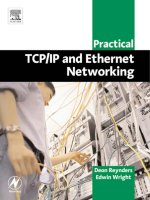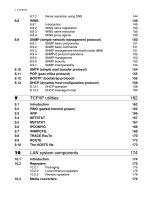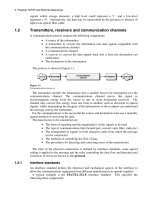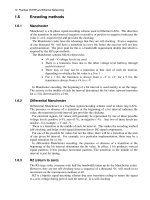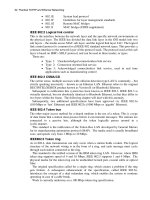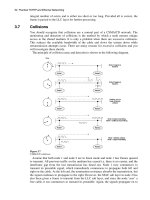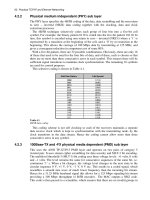Practical TCP/IP and Ethernet Networking- P28 pptx
Bạn đang xem bản rút gọn của tài liệu. Xem và tải ngay bản đầy đủ của tài liệu tại đây (112.61 KB, 5 trang )
/TZKXTKZRG_KXVXUZUIURY
Figure 6.42
Application of routing protocols
In a simple AS consisting of only a few physical networks, the routing function
provided by IP may be sufficient. In larger ASs, however, sophisticated routers using
adaptive routing algorithms may be needed. These routers will communicate with each
other using interior gateway protocols such as RIP, Hello, IS-IS or OSPF.
Routers in different ASs, however, cannot use IGPs for communication for more than
one reason. Firstly, IGPs are not optimized for long-distance path determination.
Secondly, the owners of ASs (particularly Internet service providers) would find it
unacceptable for their routing metrics (which include sensitive information such as error
rates and network traffic) to be visible to their competitors. For this reason routers that
communicate with each other and are resident in different ASs communicate with each
other using exterior gateway protocols.
The routers on the periphery, connected to other ASs, must be capable of handling both
the appropriate IGPs and EGPs.
The most common exterior gateway protocol currently used in the TCP/IP environment
is border gateway patrol (BGP), the current version being BGP-4.
A third type of routing protocol is used by the core routers (gateways) that connect
users to the Internet backbone. They use gateway to gateway protocols (GGP) to
communicate with each other.
/TZKXOUXMGZK]G_VXUZUIURY
The protocols that will be discussed are RIPv2 (routing information protocol version 2),
EIGRP (enhanced interior gateway routing protocol), and OSPF (open shortest path
first).
8/6\
RIPv2 originally saw the light as RIP (RFC 1058, 1388) and is one of the oldest routing
protocols. The original RIP had a shortcoming in that it could not handle variable-length
6XGIZOIGR:)6/6GTJ+ZNKXTKZ4KZ]UXQOTM
subnet masks, and hence could not support CIDR. This capability has been included with
RIPv2.
RIPv2 is a distance vector routing protocol where each router, using a special packet to
collect and share information about distances, keeps a routing table of its perspective of
the network showing the number of hops required to reach each network. RIP uses as a
metric (i.e. form of measurement) the hop counts.
In order to maintain their individual perspective of the network, routers periodically
pass copies of their routing tables to their immediate neighbors. Each recipient adds a
distance vector to the table and forwards the table to its immediate neighbors. The hop
count is incremented by one every time the packet passes through a router. RIP only
records one route per destination (even if there are more).
The Figure 6.43 shows a sample network and the relevant routing tables.
The RIP routers have fixed update intervals and each router broadcasts its entire routing
table to other routers at 30-second intervals (60 seconds for netware RIP). Each router
takes the routing information from its neighbor, adds or subtracts one hop to the various
routes to account for itself, and then broadcasts its updated table.
Every time a router entry is updated, the timeout value for the entry is reset. If an entry
has not been updated within 180 seconds it is assumed suspect and the hop field set to 16
to mark the route as unreachable and it is later removed from the routing table.
One of the major problems with distance vector protocols like RIP is the convergence
time, which is the time it takes for the routing information on all routers to settle in
response to some change to the network. For a large network the convergence time can
be long and there is a greater chance of frames being misrouted.
Figure 6.43
RIP tables
RIPv2 (RFC1723) also supports:
• Authentication
This prevents a routing table from being corrupted with incorrect data from a
bad source
• Subnet masks
The IP address and its subnet mask enable the RIPv2 to identify the type of
destination that the route leads to. This enables it to discern the network
subnet from the host address
/TZKXTKZRG_KXVXUZUIURY
• IP identification
This makes RIPv2 more effective than RIP as it prevents unnecessary hops.
This is useful where multiple routing protocols are used simultaneously and
some routes may never be identified. The IP address of the next hop router
would be passed to neighboring routers via routing table updates. These
routers would then force datagrams to use a specific route whether or not
that route had been calculated to be the optimum route or not using least hop
count
• Multicasting of RIPv2 messages
This is a method of simultaneously advertising routing data to multiple RIP
or RIPv2 devices. This is useful when multiple destinations must receive
identical information
+/-86
EIGRP is an enhancement of the original IGRP, a proprietary routing protocol developed
by Cisco Systems for use on the Internet. IGRP is outdated since it cannot handle CIDR
and variable-length subnet masks.
EIGRP is a distance vector routing protocol that uses a composite metric for route
calculations. It allows for multipath routing, load balancing across 2, 3 or 4 links, and
automatic recovery from a failed link. Since it does not only take hop count into
consideration, it has better real-time appreciation of the link status between routers and is
more flexible than RIP. Like RIP it broadcasts whole routing table updates, but at
90 second intervals.
Each of the metrics used in the calculation of the distance vectors has a weighting
factor. The metrics used in the calculation are as follows:
• Hop count. Unlike RIP, EIGRP does not stop at 16 hops and can operate up
to a maximum of 255
• Packet size (maximum transmission unit or MTU)
• Link bandwidth
• Delay
• Loading
• Reliability
The metric used is:
Metric = K1 * bandwidth + (K2 * bandwidth)/(256 – Load) + K3 * Delay
(K1, K2 and K3 are weighting factors.)
Reliability is also added in using the metric:
Metric
modified
= Metric * K5/(reliability + K4)
This modifies the existing metric calculated in the first equation above.
One of the key design parameters of EIGRP is complete independence from routed
protocols. Hence EIGRP has implemented a modular approach to supporting routed
protocols and can easily be retrofitted to support any other routed protocol.
596,
This was designed specifically as an IP routing protocol, hence it cannot transport IPX or
Appletalk protocols. It is encapsulated directly in the IP protocol. OSPF can quickly
detect topological changes by flooding link state advertisements to all the other neighbors
with reasonably quick convergence.
6XGIZOIGR:)6/6GTJ+ZNKXTKZ4KZ]UXQOTM
OSPF is a link state routing or shortest path first (SPF) protocol detailed in RFCs 1131,
1247 and 1583. Here each router periodically uses a broadcast mechanism to transmit
information to all other routers, about its own directly connected routers and the status of
the data links to them. Based on the information received from all the other routers each
router then constructs its own network routing tree using the shortest path algorithm.
These routers continually monitor the status of their links by sending packets to
neighboring routers. When the status of a router or link changes, this information is
broadcast to the other routers that then update their routing tables. This process is known
as flooding and the packets sent are very small representing only the link state changes.
Using cost as the metric OSPF can support a much larger network than RIP, which is
limited to 15 routers. A problem area can be in mixed RIP and OSPF environments if
routers go from RIP to OSPF and back when hop counts are not incremented correctly.
+^ZKXOUXMGZK]G_VXUZUIURY+-6Y
One of the earlier EGPs was, in fact called EGP! The current de facto Internet standard
for inter-domain (AS) routing is border gateway patrol version 4, or simply BGP-4.
(-6
BGP-4, as detailed in RFC 1771, performs intelligent route selection based on the shortest
autonomous system path. In other words, whereas interior gateway protocols such as RIP
make decisions on the number of ROUTERS to a specific destination, BGP-4 bases its
decisions on the number of AUTONOMOUS SYSTEMS to a specific destination. It is a
so-called path vector protocol, and runs over TCP (port 179).
BGP routers in one autonomous system speak BGP to routers in other autonomous
systems, where the ‘other’ autonomous system might be that of an Internet service
provider, or another corporation. Companies with an international presence and a large,
global WAN, may also opt to have a separate AS on each continent (running OSPF
internally) and run BGP between them in order to create a clean separation.
GGP comes in two ‘flavors’ namely ‘internal’ BGP (iBGP) and ‘external BGP’
(eBGP). IBGP is used within an AS and eBGP between ASs. In order to ascertain which
one is used between two adjacent routers, one should look at the AS number for each
router. BGP uses a formally registered AS number for entities that will advertise their
presence in the Internet. Therefore, if two routers share the same AS number, they are
probably using iBGP and if they differ, the routers speak eBGP. Incidentally, BGP
routers are referred to as ‘BGP speakers’, all BGP routers are ‘peers’, and two adjacent
BGP speakers are ‘neighbors.’
The range of non-registered (i.e. private) AS numbers is 64512–65535 and ISP
typically issues these to stub ASs i.e. those that do not carry third-party traffic.
As mentioned earlier, iBGP is the form of BGP that exchanges BGP updates within an
AS. Before information is exchanged with an external AS, iBGP ensures that networks
within the AS are reachable. This is done by a combination of ‘peering’ between BGP
routers within the AS and by distributing BGP routing information to IGPs that run
within the AS, such as EIGRP, IS-IS, RIP or OSPF. Note that, within the AS, BGP peers
do not have to be directly connected as long as there is an IGP running between them.
The routing information exchanged consists of a series of AS numbers that describe the
full path to the destination network. This information is used by BGP to construct a loop-
free map of the network.
In contrast with iBGP, eBGP handles traffic between routers located on DIFFERENT
ASs. It can do load balancing in the case of multiple paths between two routers. It also
/TZKXTKZRG_KXVXUZUIURY
has a synchronization function that, if enabled, will prevent a BGP router from
forwarding remote traffic to a transit AS before it has been established that all internal
non-BGP routers within that AS are aware of the correct routing information. This is to
ensure that packets are not dropped in transit through the AS.
